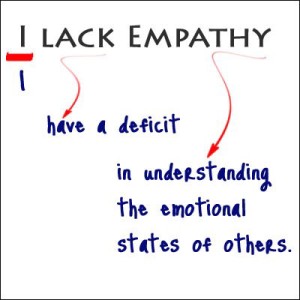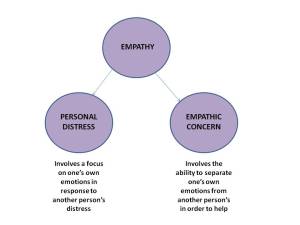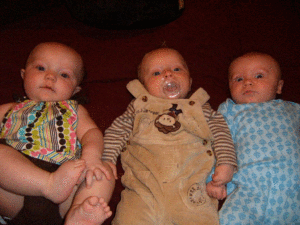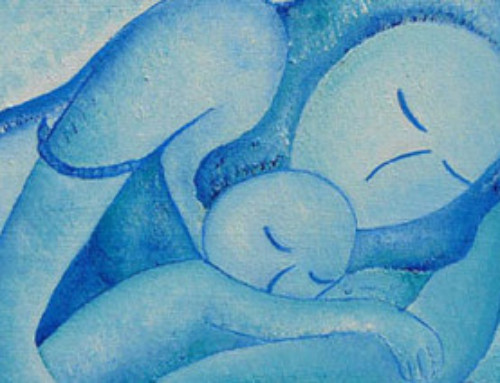 One of the main goals of all parents is to hopefully instill our children with a sense of empathy and regard for others. Although I think we do a pretty poor job of it overall for many reasons (empathy has been declining for years
One of the main goals of all parents is to hopefully instill our children with a sense of empathy and regard for others. Although I think we do a pretty poor job of it overall for many reasons (empathy has been declining for years
New research out in The Journal of Neuroscience helps shed some light on how our development of empathy helps shape the way we view others and our interactions with them. Although it’s not surprising that higher levels of empathy are associated with greater social well-being[2] given how integral it is for us to be able to feel what others feel to try and help them, this new research actually suggests that it goes beyond that.
(The next bit is technical, but after will be a discussion of what these findings mean, especially how they pertain to parenting and fostering empathy in our children. Scroll down to “What This Means” if you want to skip the technical stuff.)
The Research
The research, run jointly between the University College London and the University of Oxford, both in the UK, examined how the brain responds to other people receiving rewards, with some interesting findings[3]. As a bit of background, researchers have previously identified an area in the brain – the dorsal anterior cingulate cortex (dACC) – as one that is activated when we receive rewards, enabling us to monitor the likelihood of receiving rewards. Recently, other research suggests that a subregion of the dACC, the anterior cingulate cortex in the gyrus (ACCg), is active when others receive rewards as the dACC is also active when processing social information. Thus, one goal of the current study was to simply determine if the ACCg was active for others’ as it is for oneself.
Notably, this same subregion of the brain (the ACCg) has been found to be active when individuals are empathizing with others, specifically when others are feeling pain or another negative outcome. However, it is unclear if it is active during any empathic reactions to others’ positive situations, such as receiving a reward. The second goal of the research, therefore, was to determine if there was a relationship between this experience of empathy and the awareness or prediction of others receiving rewards.
The task for participants (whom were all male) involved 50 trials in which they either won or lost based on the probability of winning or losing which was presented ahead of time (high versus low). The outcome was dictated for them (i.e., no skill necessary) so there was no competition for winning or losing. They also observed 50 trials for a confederate which were exactly the same. Winning involved extra monetary payment and the participants believed the confederate would also receive additional payments when they won. In order to engage participants, they were asked to report if the outcome was expected or not based on the pre-trial probability of winning shown to them. This was done for both their own trials and the confederate trials. They were also asked to report how they felt when they won versus lost and how they felt when the confederate won versus lost. Additionally, fMRI data was collected during the trials.
 Participants completed a questionnaire designed to assess trait-level empathy and includes five subscales: perspective-taking (the ability to identify other people’s thoughts), online simulation (how readily one imagines another’s reaction before acting), emotion contagion (how much others’ emotions influence one’s own), peripheral responsivity (degree of engagement in the arts, like plays, movies or books), and proximal responsivity (degree of engagement in the situations of friends and those around us). Suffice it to say, the measure is newer (it was developed in 2011) and seems well-validated and the subscales are important components of trait empathy.
Participants completed a questionnaire designed to assess trait-level empathy and includes five subscales: perspective-taking (the ability to identify other people’s thoughts), online simulation (how readily one imagines another’s reaction before acting), emotion contagion (how much others’ emotions influence one’s own), peripheral responsivity (degree of engagement in the arts, like plays, movies or books), and proximal responsivity (degree of engagement in the situations of friends and those around us). Suffice it to say, the measure is newer (it was developed in 2011) and seems well-validated and the subscales are important components of trait empathy.
The Findings
First, individuals reported being happier whenever anyone won versus lost, but this difference was much greater when it was self-directed. That is, participants reported being significantly happier when they won versus lost and significantly happier when they won versus when the confederate won. This shouldn’t be too surprising. Somewhat surprisingly, there were reaction time differences in assessing how expected an outcome was for self versus other trials, with individuals being faster at responding for their own trials versus those of the confederate. These differences were also linked to the emotion contagion subscale, suggesting that those who were more likely to be influenced by others’ emotional states were faster at responding to the expectedness of the outcome for the confederate.
With respect to the fMRI data, the activation of the ACCg was found to be aligned with a high probability of the other individual receiving a reward versus when there was a low probability of the other receiving a reward, confirming that the ACCg is active in predicting others’ likelihood of receiving a reward. In fact, the activation for others’ was (1) greater than for the self, suggesting a key role for the ACCg in monitoring social information (in line with findings that it is active during periods of empathy), and (2) in the opposite direction than for the self (i.e., the ACCg was active when probability was low for the self, but active when probability of reward was high for the other).
Perhaps more interestingly was the relationship between the activation of the ACCg and trait empathy. Specifically, the researchers created an interaction contrast estimate for ACCg activation based on its activation for the self versus other (i.e., other high vs low probability minus self high vs low probability) and compared this estimate to the various subscales of trait empathy. Once again, emotion contagion was significantly related to this estimate such that the interaction was weakest for those highest on emotion contagion. This interaction seemed to be due to an attenuation of the low vs high probability distinction for the self. That is, those who were high on emotion contagion showed activation of the ACCg only when others’ were set to receive a reward and not for themselves whereas those low on emotion contagion also showed activation for the self in this area.
What Does This Mean?
It is imperative that I first mention this research was conducted on males only. This is good for the research as it is preliminary and you don’t want sex differences when you can only have a small sample size for fMRI research (cost reasons) so it’s not a fault of the researchers, but I do wonder if women would either have more specializations in the area or other differences. They may, they may not. We need more research on this specifically to be sure.
From a parenting perspective, the importance of this research to me (and why I felt the need to cover it) lies in what we know of how our brains develop. Let me take a step back. One possible interpretation of this research is that our levels of empathy predict the degree of specialization of the ACCg, with those higher on empathy (emotion contagion in particular, which is the affective side of empathy over the cognitive), showing greater specialization. However, it is either equally or more likely that the relationship exists in the other direction: The degree of specialization in the area predicts emotion contagion.
If this is the direction in which the findings lie, then we have to ask how we can ensure appropriate specialization of the ACCg in the brain to maximize empathy. As we know, the brain requires repeated patterns to develop and specialize. Crucial to this, the ACCg seems to be one “social” area of the brain and yet is also very close to the dACC, the area that focuses on the self with respect to reward. There is evidence that perhaps the two areas may compete at times and that this may play a role in the type of specialization the ACCg develops. Of interest here is research that has found that stimulation of individual neurons in the dACC results in competitive social interactions in primates[4], suggesting the activation of “reward for me” may dampen the “reward for you” response, placing the two types of reward in opposition to each other. It is possible, though we don’t know, that when faced with repeated competitive social interactions, the self area starts to take over the ACCg, which is what was seen in those low on emotion contagion.
 In short, if “you win”, what happens to me? It is possible that if a child who is repeatedly exposed to competition, “you win” becomes associated with “I lose” and thus empathy also does not develop. However, if “you win” can simply be what it is, unassociated with the self (or even positively associated with the self), then we may have a greater basis for the specialization of the ACCg to focus on others and the associated empathy that seems to go with it.
In short, if “you win”, what happens to me? It is possible that if a child who is repeatedly exposed to competition, “you win” becomes associated with “I lose” and thus empathy also does not develop. However, if “you win” can simply be what it is, unassociated with the self (or even positively associated with the self), then we may have a greater basis for the specialization of the ACCg to focus on others and the associated empathy that seems to go with it.
Some may question here if babies understand rewards and there is evidence that they do, though good understand takes time to develop[5]. As neural development occurs over several years (typically the first 2-3 are thought to be the most crucial), there is ample time for children to experience cooperative or competitive environments and situations that might help the ACCg develop into the social specialty area it seems it is designed for. Cooperative games, modeling sharing (but not forcing it because that actually is a “you win, I lose” situation), and so on are ways in which we can expose the child to this type of cooperative environment. Notably, children naturally seem to show altruism, and our rewarding of this actually leads to less altruism[6], possibly because it again creates an overlap between activation of the dACC and ACCg, though that is speculation.
Furthermore, in infancy, repeated responsiveness to distress and warmth allow the child to not become self-focused on their own internal state. By responding, we allow our children to regulate and then look towards others; indeed, co-regulation enforces this “I win, you win” situation at a physiological level. Is it any wonder then that responsiveness to distress is linked to later empathic behaviours[2]? Although there is a lot still unknown about this region and the exact ways in which we can help facilitate empathic development in our children, this new research fits nicely with previous work on empathy that highlights the role of responsiveness and a modeling of focus on others versus the self to help develop this critical skill.
_______________
[1] Konrath SH, O’Brien EH, Hsing C. Changes in dispositional empathy in American college students over time: a meta-analysis. Personality and Social Psychology Review 2011; 15: 180-98. [2] Grusec JE. Socialization processes in the family: social and emotional development. Annual Reviews in Psychology 2011; 62: 243-69. [3] Lockwood PL, Apps MAJ, Roiser JP, Viding E. Encoding of vicarious reward prediction in anterior cingulate cortex and relationship with trait empathy. The Journal of Neuroscience 2015; 35: 13720-7. [4] Haroush K, Williams ZM. Neuronal prediction of opponent’s behavior during cooperative social interchange in primates. Cell 2015; 160: 1233-45. [5] Diamond A, Churchland A, Cruess L, Kirkham NZ. Early developments in the ability to understand the relation between stimulus and reward. Developmental Psychology 1999; 35: 1507-17. [6] Warneken F, Tomasello M. Extrinsic rewards undermine altruistic tendencies in 20-month-olds. Motivation Science 2014; 1: 43-8.





[…] Source: Empathy and Specialization in the Brain | Evolutionary Parenting | Where History And Science Meet Pa… […]
This is such a wonderful breakdown of the neurobiology behind empathy! Many parents are curious how they can increase empathy in their children, or at least raise children to become empathic. It seems that traditional advice, which essentially forces empathy, is doing more harm than good! Indeed, it is always best to start these lessons while the brain is still developing. Thank you for writing on this topic!